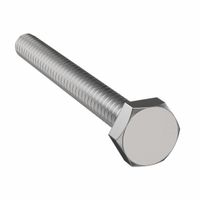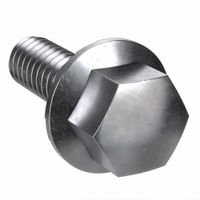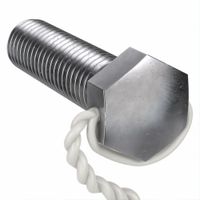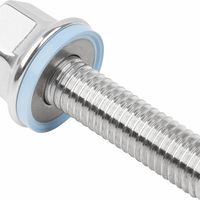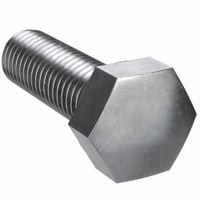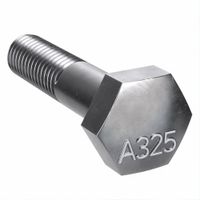Call +(254) 703 030 000 / 751 483 999 / 721 704 777
- Home
- Fasteners
- Bolts Screws
- Hex Head Bolts
.....Read More
Frequently Asked Questions
What are hex head bolts used for?
Hex head bolts are used in a wide range of applications due to their robust design and ease of use. They are commonly employed in construction, machinery, and automotive industries. The hexagonal head allows for easy wrenching, providing a strong grip for tightening or loosening. This makes them ideal for securing heavy-duty materials and components.
In construction, hex head bolts are used to join wood, metal, and other materials, providing structural integrity to buildings and infrastructure. They are often used in steel fabrication, where they secure beams and columns, ensuring stability and safety.
In machinery, hex head bolts are essential for assembling and maintaining equipment. They are used to fasten parts that require frequent disassembly and reassembly, such as in engines and industrial machines. Their design allows for high torque application, ensuring a tight fit that can withstand vibrations and heavy loads.
In the automotive industry, hex head bolts are used to assemble vehicles, securing parts like engines, transmissions, and chassis components. Their strength and reliability are crucial for vehicle safety and performance.
Additionally, hex head bolts are used in DIY projects and home repairs, offering a versatile solution for various fastening needs. They come in different sizes and materials, such as stainless steel, carbon steel, and alloy steel, to suit different environmental conditions and load requirements.
Overall, hex head bolts are valued for their durability, versatility, and ease of use, making them a staple in numerous applications across different industries.
How do you measure a hex head bolt?
To measure a hex head bolt, follow these steps:
1. **Length Measurement**: Use a ruler or caliper to measure the length from the flat part of the head to the tip of the bolt. For bolts that are fully threaded, measure from the bottom of the head to the end of the threads.
2. **Diameter Measurement**: Measure the diameter of the bolt's shank (the unthreaded part) using a caliper. This is the nominal diameter and is typically the size referred to when identifying the bolt (e.g., M8, 1/4 inch).
3. **Thread Pitch Measurement**: For metric bolts, measure the distance between threads using a thread pitch gauge. For imperial bolts, count the number of threads per inch (TPI).
4. **Head Size Measurement**: Measure the distance across the flats of the hex head using a caliper or a wrench that fits snugly. This is the size of the wrench or socket needed to tighten or loosen the bolt.
5. **Thread Length Measurement**: If the bolt is partially threaded, measure the length of the threaded portion separately.
6. **Grade and Material Identification**: Check for markings on the head of the bolt, which indicate the grade and material. This is important for determining the bolt's strength and suitability for specific applications.
7. **Finish and Coating**: Visually inspect the bolt for any coatings or finishes, such as zinc plating or galvanization, which can affect corrosion resistance.
By accurately measuring these aspects, you can ensure the correct bolt is used for your application, ensuring proper fit and function.
What is the difference between a hex bolt and a hex cap screw?
A hex bolt and a hex cap screw are both fasteners with hexagonal heads, but they have distinct differences in design and application.
1. **Threading**:
- **Hex Bolt**: Typically has partially threaded shanks. The unthreaded portion provides a stronger grip when used in conjunction with a nut.
- **Hex Cap Screw**: Usually fully threaded, which allows for more precise alignment and clamping force when used in tapped holes.
2. **Application**:
- **Hex Bolt**: Commonly used in construction and repair applications where the bolt is inserted through a hole and secured with a nut. The unthreaded shank provides shear strength.
- **Hex Cap Screw**: Often used in machinery and equipment where precise alignment is crucial. They are screwed directly into a tapped hole without the need for a nut.
3. **Manufacturing Standards**:
- **Hex Bolt**: Generally manufactured to less stringent tolerances. They are often used in applications where precision is not critical.
- **Hex Cap Screw**: Made to tighter tolerances and often have a washer face under the head for better load distribution. They are used in applications requiring precise torque specifications.
4. **Head Design**:
- **Hex Bolt**: The head is typically flat on the underside, which can affect the distribution of load.
- **Hex Cap Screw**: Often features a washer face under the head, providing a more even distribution of load and reducing the risk of damage to the surface.
5. **Usage Context**:
- **Hex Bolt**: Preferred in applications where the bolt is not subjected to high precision requirements.
- **Hex Cap Screw**: Used in applications where precision and alignment are critical, such as in automotive and machinery assembly.
In summary, while both fasteners serve similar purposes, hex cap screws are generally used in more precise applications due to their full threading and tighter manufacturing tolerances.
How do you tighten a hex head bolt?
To tighten a hex head bolt, first ensure you have the appropriate tools, such as a wrench or socket set that matches the bolt size. Begin by selecting the correct size socket or wrench to fit the hex head snugly. Place the socket or wrench over the bolt head, ensuring a firm grip to prevent slipping.
Position yourself comfortably to apply even pressure. Turn the wrench or socket handle clockwise to tighten the bolt. If using a ratchet, ensure it is set to tighten. Apply steady, even pressure to avoid stripping the bolt head or damaging the threads. If the bolt is part of a larger assembly, ensure all components are aligned correctly before tightening.
For precise applications, use a torque wrench to apply the manufacturer's specified torque. This ensures the bolt is neither too loose nor overtightened, which could lead to component failure or damage. Adjust the torque wrench to the required setting, and tighten the bolt until the wrench clicks, indicating the correct torque has been reached.
If the bolt is difficult to turn, check for rust or debris in the threads. Clean the threads with a wire brush or apply a penetrating oil to ease the process. Avoid using excessive force, as this can damage the bolt or the material it is securing.
Once tightened, inspect the bolt and surrounding area to ensure everything is secure and properly aligned. If necessary, recheck the torque after a short period of use, as some assemblies may settle or shift slightly.
What materials are hex head bolts made from?
Hex head bolts are manufactured from a variety of materials, each chosen for specific properties that suit different applications. Common materials include:
1. **Carbon Steel**: This is the most common material for hex head bolts, offering a good balance of strength and cost-effectiveness. They are often coated with zinc or black oxide for corrosion resistance.
2. **Stainless Steel**: Known for its excellent corrosion resistance, stainless steel hex bolts are ideal for environments exposed to moisture or chemicals. Grades like 304 and 316 are popular, with 316 offering superior resistance to corrosion.
3. **Alloy Steel**: These bolts are made from steel alloyed with elements like chromium, molybdenum, or nickel to enhance strength and toughness. They are often used in high-stress applications and may be heat-treated for additional strength.
4. **Brass**: Brass hex bolts are used for their corrosion resistance and electrical conductivity. They are often found in applications where aesthetics are important or where non-magnetic properties are required.
5. **Aluminum**: Lightweight and corrosion-resistant, aluminum hex bolts are used in applications where weight is a concern, such as in aerospace or automotive industries.
6. **Titanium**: Known for its high strength-to-weight ratio and excellent corrosion resistance, titanium hex bolts are used in high-performance applications, including aerospace and medical devices.
7. **Nylon and Plastics**: For non-metallic applications, hex bolts can be made from nylon or other plastics. These are used where electrical insulation, corrosion resistance, or reduced weight is needed.
Each material offers distinct advantages and is selected based on the specific requirements of the application, such as load-bearing capacity, environmental conditions, and cost considerations.
What are the advantages of using hex head bolts?
Hex head bolts offer several advantages:
1. **Ease of Use**: The six-sided head allows for easy gripping with tools like wrenches and sockets, facilitating quick and efficient tightening or loosening.
2. **High Torque Application**: The design enables the application of high torque without damaging the bolt, making them suitable for heavy-duty applications.
3. **Versatility**: Available in various sizes and materials, hex head bolts can be used in a wide range of applications, from construction to automotive industries.
4. **Strength and Durability**: Typically made from strong materials like steel, they provide excellent tensile strength and durability, ensuring long-lasting performance.
5. **Alignment and Stability**: The flat surfaces of the hex head provide stability and prevent slippage during installation, ensuring precise alignment.
6. **Accessibility**: The shape allows for easy access in tight spaces where other bolt types might be difficult to maneuver.
7. **Standardization**: Widely standardized, making them easy to replace or find in hardware stores globally.
8. **Corrosion Resistance**: Often available with coatings or made from materials that resist corrosion, enhancing their longevity in harsh environments.
9. **Cost-Effectiveness**: Generally affordable and widely available, making them a cost-effective choice for many projects.
10. **Compatibility with Power Tools**: Compatible with various power tools, which speeds up the installation process and reduces labor costs.
These advantages make hex head bolts a popular choice in many industries for securing components and structures.
How do you choose the right size hex head bolt?
To choose the right size hex head bolt, consider the following factors:
1. **Application Requirements**: Determine the load and stress the bolt will endure. This includes tensile, shear, and fatigue stresses. The bolt must be strong enough to handle these forces without failure.
2. **Material Compatibility**: Select a bolt material compatible with the materials being joined. Consider factors like corrosion resistance, temperature, and environmental conditions.
3. **Bolt Diameter**: Choose a diameter that provides sufficient strength. Larger diameters generally offer higher strength but may require larger holes and more space.
4. **Thread Pitch**: Select the appropriate thread pitch (coarse or fine) based on the application. Coarse threads are better for quick assembly and disassembly, while fine threads offer better holding power and are suitable for precision applications.
5. **Length**: Ensure the bolt is long enough to pass through all components and allow for proper engagement with the nut or threaded hole. Typically, at least two full threads should protrude beyond the nut for secure fastening.
6. **Head Size and Type**: Choose a head size that fits the available space and provides the necessary torque application. Consider the tool access and clearance around the bolt head.
7. **Standards and Specifications**: Refer to industry standards (e.g., ISO, ANSI, DIN) for guidance on bolt dimensions and tolerances. Ensure compliance with any specific standards required for your application.
8. **Safety and Regulations**: Consider any safety regulations or industry standards that apply to your application, ensuring the bolt size and type meet these requirements.
9. **Consultation**: When in doubt, consult with engineers or use design software to ensure the selected bolt meets all mechanical and safety requirements.
By considering these factors, you can select the appropriate hex head bolt size for your specific application.
